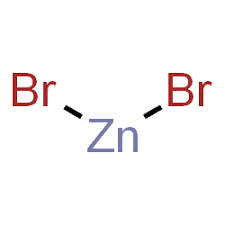
Zinc bromide is a chemical compound with various formula variations, each of which reveals distinct properties and applications. Zinc Bromide formula is composed of Zinc and Bromine, two elements found in the periodic table. Zinc, the first element in group-12, has the atomic number 30 and symbol Zn. It is a commonly utilized silvery-greyish brittle metal. On the other hand, Bromine, present in group-17, is a volatile red-brown liquid that quickly turns into vapor at room temperature. Its atomic number is 35 and it is represented by the symbol Br.
Zinc Bromide Formula
The formula for zinc bromide is ZnBr₂. This chemical formula signifies the combination of one zinc ion (Zn²⁺) and two bromide ions (Br⁻). It's a binary ionic compound where zinc, a metal, forms a 2+ cation, and bromine, a non-metal, forms 1- anions, resulting in a 1:2 ratio.
Zinc Bromide Formula is composed of two elements, zinc and bromine. Zinc, with an atomic number of 30 and the symbol Zn, is a brittle silver-gray metal found in group 12 of the periodic table. It is commonly used and known for its wide range of applications. On the other hand, bromine, represented by the symbol Br and with an atomic number of 35, is a reddish-brown volatile liquid that easily evaporates at room temperature. This element can be found in group 17 of the periodic table. Just like zinc, it also has various uses.

Aqueous Zinc Bromide Formula
In an aqueous solution, zinc bromide dissociates into its constituent ions. Therefore, the formula for aqueous zinc bromide is written as Zn²⁺(aq) + 2Br⁻(aq). The "(aq)" indicates that the compound is dissolved in water and exists as ions in solution.
Zinc Bromide Ionic Formula
Zinc bromide is an ionic compound. Ionic compounds are formed by the transfer of electrons from one element to another, leading to the attraction between oppositely charged ions. In the case of zinc bromide, the ionic formula is Zn²⁺(cation) + 2Br⁻(anions), reflecting the electrostatic interaction between the two types of ions.
Zinc and Bromide Ions Formula
The formula for the individual ions in zinc bromide is:
- Zinc ion: Zn²⁺
- Bromide ion: Br⁻
These formulas indicate the charge of each ion. Zinc has a 2+ charge, and bromide has a 1- charge. In zinc bromide, one zinc ion combines with two bromide ions, resulting in the compound ZnBr₂, as mentioned earlier. Understanding the individual ion formulas is essential for predicting how elements combine to form compounds and perform chemical calculations.
Properties of Zinc Bromide
Zinc bromide (ZnBr₂) is a chemical compound with several notable properties and applications. Here are some key properties of zinc bromide:
| Properties of Zinc Bromide | |
| Chemical Formula | ZnBr 2 |
| Appearance | White crystalline powder |
| Molecular weight | 225.188 g/mol |
| Melting Point | 394 °C |
| Boiling point | 697 °C |
| Solubility | Soluble in alcohol, ether, acetone, tetrahydrofuran |
| Density | 4.20 g/cm 3 |
Preparation of Zinc Bromide
Zinc Bromide Formula is made by treating zinc oxide (or) zinc metal with hydrobromic acid.
ZnO + 2HBr + H2O → ZnBr2 2H2O
Zn + 2HBr → ZnBr2 + H2
Zinc oxide reacts with hydrobromic acid to form ZnBr2 2H2O, which can be dehydrated to anhydride with CO2.
Zinc Bromide Formula (ZnBr2) has a similar structure to zinc iodide (ZnI2). The Zn ion has a charge of +2 and each bromide ion has a charge of -1.
Uses of Zinc Bromide
- In zinc bromide batteries, zinc bromide is used as an electrolyte.
- As a Lewis acid, Zinc Bromide is used in organic chemistry.
- When transitioning from drilling to completion, zinc bromide (ZnBr2) solutions displace drilling mud.
- Radiation shielding is achieved by using it as a transparent film.
| Related Links | |
| Barium Nitrate Formula | Zinc Sulfide Formula |
| Barium Phosphate Formula | Bromine Formula |
Zinc Bromide Formula FAQs
How do you write zinc bromide?
What is the formula for zinc bromate?
What is the balanced formula for zinc bromide?
How is zinc bromide formed?










